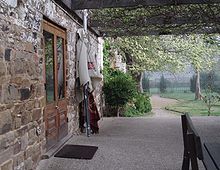Country club
The examples and perspective in this article deal primarily with the United States and do not represent a worldwide view of the subject. (December 2020) |

A country club is a privately owned club, often with a membership quota and admittance by invitation or sponsorship, that generally offers both a variety of recreational sports and facilities for dining and entertaining. Typical athletic offerings are golf, tennis, and swimming. Where golf is the principal or sole sporting activity, and especially outside of the United States, it is common for a country club to be referred to simply as a golf club.
Country clubs are most commonly located in city outskirts or suburbs,[1] due to the requirement of having substantial grounds for outdoor activities, which distinguishes them from an urban athletic club.
Country clubs originated in Scotland[2] and first appeared in the US in the early 1880s.[3] Country clubs had a profound effect on expanding suburbanization[4] and are considered to be the precursor to gated community development.[3]
By nation[]
United States[]
Country clubs can be exclusive organizations. In small towns, membership in the country club is often not as exclusive or expensive as in larger cities where there is competition for a limited number of memberships. In addition to the fees, some clubs have additional requirements to join. For example, membership can be limited to those who reside in a particular housing community.
Country clubs were founded by upper-class elites between 1880 and 1930.[5][6] By 1907, country clubs were claimed to be “the very essence of American upper-class.”[4] The number of country clubs increased exponentially with industrialization, the rise in incomes, and suburbanization in the 1920s.[4] During the 1920s, country clubs acted as community social centers.[4] When people lost most of their income and net worth during the Great Depression, the number of country clubs decreased drastically for lack of membership funding.[4]
Historically, many country clubs were "restricted" and refused to admit members of minority racial groups as well those of specific faiths, such as Jews and Catholics.[7] Beginning in the 1960s civil rights lawsuits forced clubs to drop exclusionary policies.[citation needed] In a 1990 landmark ruling at Shoal Creek Golf and Country Club, the PGA refused to hold tournaments at private clubs that practiced racial discrimination.[8] This new regulation led to the admittance of black people at private clubs. The incident at Shoal Creek is comparable to the 1966 NCAA Basketball Tournament, which led to the end of racial discrimination in college basketball.
The Philadelphia Cricket Club is the oldest organized country club in the United States devoted to playing games,[9] while The Country Club in Brookline, Massachusetts is the oldest club devoted to golf.
United Kingdom[]
In the United Kingdom, many country clubs are simply golf clubs, and play a smaller role in their communities than American country clubs;[citation needed] gentlemen's clubs in Britain—many of which admit women while remaining socially exclusive—fill many roles of the United States' country clubs.[citation needed]
Indian Subcontinent[]
Many of the gentlemen's clubs established during the British Raj are still active in major cities, for example the Bangalore Club, Nizam Club, and Bengal Club.
Gymkhanas are sporting or social clubs across the subcontinent.
Australia[]

Country clubs exist in multiple forms, including athletic-based clubs and golf clubs. Examples are the Breakfast Point Country Club and Cumberland Grove Country Club in Sydney,[10] the Castle Hill Country Club,[11] the Gold Coast Polo & Country Club, Elanora Country Club,[12] and the Sanctuary Cove's Country Club.[13]
Japan[]
In Japan, almost all golf clubs are called "Country Clubs" by their owners.[citation needed]
See also[]
References[]
- ^ "Country club". Oxford Dictionaries – Dictionary, Thesaurus, & Grammar.
- ^ Wray Vamplew, “Sharing Space: Inclusion, Exclusion and Accommodation at the British Golf Club before 1914” Journal of Sport and Social Issues 34, no. 359 (2010): 359, doi: 10.1177/0193723510377327.
- ^ Jump up to: a b Simon, Roger D. “Country Clubs.” In The Encyclopedia of American Urban History, edited by David R. Goldfield, 193-94. Thousand Oaks, CA: SAGE Publications, Inc., 2007. doi: 10.4135/9781412952620.n110.
- ^ Jump up to: a b c d e Gordon, John Steele, “The Country Club”[dead link]. American Heritage 41, no.6 (1990): 75
- ^ Jennifer Jolly-Ryan, “Chipping Away at Discrimination at the Country Club,” Pepperdine Law Review 25, no. 495 (1998): 2 http://heinonline.org/HOL/Page?handle=hein.journals/pepplr25&div=37&g_sent=1&collection=journals
- ^ Jennifer Jolly-Ryan, “Chipping Away at Discrimination at the Country Club,” Pepperdine Law Review 25, no. 495 (1998): 496, http://heinonline.org/HOL/Page?handle=hein.journals/pepplr25&div=37&g_sent=1&collection=journals
- ^ Gritz, Jennie Rothenberg (September 2007). "The Jews in America". The Atlantic. Retrieved 14 January 2019.
- ^ Mayo, James M. (1998). "The American Country Club: An Evolving Elite Landscape". Journal of Architectural and Planning Research. 15 (1): 24–44. ISSN 0738-0895. JSTOR 43030441.
- ^ "2015 PNC headed to Philadelphia Cricket Club". PGA.com. Retrieved 2018-01-17.
- ^ "Breakfast Point Community Association". Breakfast Point Community Association. Archived from the original on 2015-07-08.
- ^ "Castle Hill Country Club – One of Sydney's premier private golf clubs". Castle Hill Country Club.
- ^ "Welcome to Elanora Country Club". Elanora Country Club.
- ^ "Sanctuary Cove Golf & Country Club – Golf Courses – Gold Coast, Brisbane". Sanctuary Cove Golf & Country Club. 10 May 2015.
| Wikimedia Commons has media related to Country clubs. |
- Sports culture
- Golf clubs and courses
- Clubs and societies
- High society (social class)
- Upper class culture
